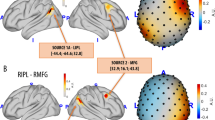Abstract
Long-term full montage (19 channels) electroencephalographic (EEG) recordings of 6 patients, treated in the Intensive Care Unit (ICU) for severe Traumatic Brain Injury (TBI), were analyzed using the methodology of connectivity analysis. Two connectivity measures, Coherence and Cross Frequency Coupling (CFC) were calculated for each pair of channels in two frequency bands, 8−13 Hz and 13−35 Hz. In the case of CFC, frequencies below 2 Hz were considered as the modulating rhythm. The ability of the measures to indicate the outcome of treatment was evaluated using the Mann-Whitney U-test. The results indicate that CFC values tend to be higher in good outcome patients for (modulating) frontal EEG channels. For the Coherence measure, U-statistic values close to 0.9 were obtained for some channel pairs, however, no clear pattern could be observed.
Preview
Unable to display preview. Download preview PDF.
Similar content being viewed by others
References
Dunham, C.M., Ransom, K.J., McAuley, C.E., Gruber, B.S., Mangalat,D., Flowers, L.L. Severe brain injury ICU outcomes are associatedwith Cranial-Arterial Pressure Index and noninvasive BispectralIndex and transcranial oxygen saturation: a prospective, preliminarystudy. Critical Care. 2006;10:R159.
Vespa, P.M., Boscardin, W.J., Hovda, D.A., et al. Early andpersistent impaired percent alpha variability on continuouselectroencephalography monitoring as predictive of poor outcomeafter traumatic brain injury. Journal of neurosurgery. 2002;97:84–92.
Mikola A., Rätsep I., Särkelä M., Lipping T.. Predictionof Outcome in Traumatic Brain Injury Patients Using Long-term qEEGFeatures. in Proc. of the 37th Annual InternationalConference of IEEE EMBS:1532–1535 2015.
Gutling, E., Gonser, A., Imhof, H.G., Landis, T. EEG reactivity inthe prognosis of severe head injury Neurology.1995;45:915–918.
McNett, M., Amato, S., Gianakis, A., et al.: The FOUR score and GCSas predictors of outcome after traumatic brain injury NeurocriticalCare. 2014;21:52–57.
Rubinov, M., Sporns, O.: Complex network measures of brainconnectivity: Uses and interpretations. NeuroImage.2010;52:1059–1069.
Vakorin, V.A., Doesburg, S.M., Costa, L., Jetly, R., Pang, E.W.,Taylor, M.J. Detecting Mild Traumatic Brain Injury Using RestingState Magnetoencephalographic Connectivity. PLoS ComputationalBiology. 2015;2015:1–41.
Dimitriadis, S.I., Laskaris, N.A., Micheloyannis, S. Transitiondynamics of EEG-based network microstates during mental arithmeticand resting wakefulness reflects task-related modulations anddevelopmental changes. Cognitive Neurodynamics.2015;9:371–387.
Kortelainen, J., Väyrynen, E., Huuskonen, U., et al. Pilot Studyof Propofol-induced Slow Waves as a Pharmacologic Test for BrainDysfunction after Brain Injury. Anesthesiology. 2017;126:94–103.
Author information
Authors and Affiliations
Corresponding author
Editor information
Editors and Affiliations
Rights and permissions
Copyright information
© 2018 Springer Nature Singapore Pte Ltd.
About this paper
Cite this paper
Lipping, T. et al. (2018). Connectivity Analysis of Full Montage EEG in Traumatic Brain Injury Patients in the ICU. In: Eskola, H., Väisänen, O., Viik, J., Hyttinen, J. (eds) EMBEC & NBC 2017. EMBEC NBC 2017 2017. IFMBE Proceedings, vol 65. Springer, Singapore. https://doi.org/10.1007/978-981-10-5122-7_25
Download citation
DOI: https://doi.org/10.1007/978-981-10-5122-7_25
Published:
Publisher Name: Springer, Singapore
Print ISBN: 978-981-10-5121-0
Online ISBN: 978-981-10-5122-7
eBook Packages: EngineeringEngineering (R0)




